

Don’t dismiss walking, it’s really is a painless and effective way of getting some good, daily exercise.
Walking is cheap and easy, and can provide enormous health benefits like improving your circulation and cardiovascular function, strengthening your bones, helping to build and maintain muscle mass, easing stress and anxiety, improving your sense of wellbeing and, if done regularly and at a high enough intensity, shed unwanted kilos.
Walk for maximum benefit
1. Keep your head up, eyes looking forward and focused ahead.
2. Ensure your back is straight, but relaxed.
3. “Zip up” your abdominals and squeeze in your gluteal (butt) muscles. This will help you maintain a straight back. The deepest layer of abdominals acts as an important stabiliser for your lower back, and is very important when walking.
4. Keep your chest out, and your shoulders back, down and relaxed.
5. Let your arms, which are bent at the elbows, swing naturally from the shoulders. As you speed up, you might find it easier to bend your arms at 90 degrees and use a stronger arm movement.
6. Your foot strike action is important. After you land on the outer side of your heel, your foot rolls inwards, which is essential for adequate shock absorption and the final phase is a push off with your toes.
7. Beware of pounding your heels down when walking briskly; this generates unnecessary forces on your joints.
8. Stride length is an individual feature of your walking technique. Most walkers take steps of the kind of length that promotes their walking efficiency.
9. Breathe rhythmically. For example inhale for three steps and exhale for the next three, or at a rate that feels right.
Walking is not as simple as it looks. Different techniques must be used for walking uphill and for downhill.

Tips for walking uphill
1. Walking uphill is quite demanding. Warm up by walking on the flat first for about five minutes.
2. Shorten your steps.
3. If you’re fit, you can quicken your step rate with shorter steps. If you’re less fit, try to maintain your step rate.
4. Lean very slightly forward into the hill. Leaning backwards will unbalance you.
5. Because hills are hard work, you should feel an increase in your heart rate and breathing rate. Make sure that you can still conduct a conversation, even if it’s somewhat breathless.

Tips for walking downhill
1. Relax and let your steps flow.
2. Going downhill, your stride will naturally lengthen. Overstriding when walking on a flat surface is bad. When going downhill it will help to brake slightly as gravity keeps you moving faster.
3. If you feel your pace is out of control, shorten your stride and slow down your step rate.
4. Stay upright and don’t lean back in an attempt to slow down.
5. If it’s a very steep downhill you might want to lean forward a little for greater stability; keep your knees slightly bent at all times.





 Publications
Publications
 Partners
Partners










